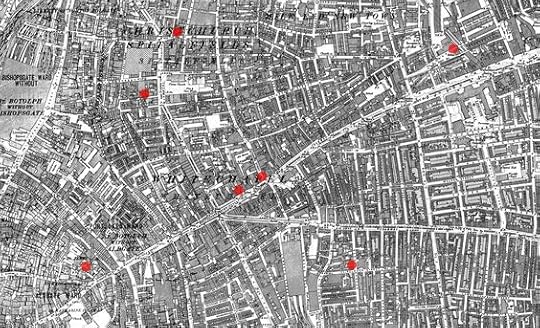History Hoydens Interview
This post originally appeared on History Hoydens. For more information on Spitalfields and weaving, check out my Pinterest board.
 Thank you so much for having me again at History Hoydens! It’s such a joy to be here. Today I’d like to tell you a little about the setting of my latest novel in my historical romantic suspense Rookery Rogues series, Secrets in Scarlet. Now, a rookery is an old term for the poorer neighborhoods in London (basically the slums).
Thank you so much for having me again at History Hoydens! It’s such a joy to be here. Today I’d like to tell you a little about the setting of my latest novel in my historical romantic suspense Rookery Rogues series, Secrets in Scarlet. Now, a rookery is an old term for the poorer neighborhoods in London (basically the slums).
While the first book in the series (A Dangerous Invitation) largely took place in the Ratcliffe rookery down by Wapping and the London Docks, Secrets in Scarlet is contained to the Spitalfields rookery in East London. Spitalfields borders up against the surrounding rookeries of Bishopgate and Whitechapel.
Spitalfields wasn’t always a rookery though—once it was a busy community teeming with prosperity. The area was home to many Huguenot weavers, who when they emigrated from France they brought with them the secrets of the silk weaving in Lyons. The entire family would help weave on draw looms or hand looms.
Everyone in Britain wanted silk woven by these ex-French weavers. Skilled weavers were certainly not a dime a dozen, and though the process was incredibly time-consuming, they were able to make a better living than they would in many of the other occupations available to the lower class.
But during the 1820’s, all that changed. Britain revoked the Spitalfields Act, and now people could trade freely with France, so the Spitalfields weavers were no longer the ones producing this silk. Coupled with the new machinery that dramatically reduced production times—and the need for so many weavers—the small town descended into hardship. As Charles Dickens states in his 1851 “Spitalfields” article for the Household Worlds journal, “From fourteen to seventeen thousand looms are contained in from eleven to twelve thousand houses – although at the time at which we write, not more than nine to ten thousand are at work.” Most of the production moved to factories in Manchester or Lancashire that utilized steam power. In my upcoming novel Beauty and the Rake, my heroine, Abigail has weaved—either in a factory or in her own home—since she was a child, and it’s all she knows.
 In Secrets in Scarlet, I created a factory that exists on White Lion Street. This factory has somewhat factual basis, because it was marked on a map I found of the Spitalfields/Whitechapel areas during the Ripper slayings (so as to whether or not there was a factory actually on this site in 1832, your guess is as good as mine, but I thought it was an interesting coincidence). My textile factory solely does the weaving of the raw silk, so no steam power is needed. My heroine, Poppy O’Reilly, goes to work as a weaver in this factory not only to pay rent, etc, but so that she can save up enough money for her daughter to attend a finishing school someday.
In Secrets in Scarlet, I created a factory that exists on White Lion Street. This factory has somewhat factual basis, because it was marked on a map I found of the Spitalfields/Whitechapel areas during the Ripper slayings (so as to whether or not there was a factory actually on this site in 1832, your guess is as good as mine, but I thought it was an interesting coincidence). My textile factory solely does the weaving of the raw silk, so no steam power is needed. My heroine, Poppy O’Reilly, goes to work as a weaver in this factory not only to pay rent, etc, but so that she can save up enough money for her daughter to attend a finishing school someday.
The new attachment made by Joseph Marie Jacquard hastened the downfall of these skilled weavers. I show this loom in Secrets in Scarlet, as my heroine Poppy works in a textile factory devoted to the weaving of silk. Though it’s often referred to as a “Jacquard loom,” it’s actually an attachment that can be used with many mechanical looms. It could be operated by one person, and because of its punch card system, suddenly it was possible to work complex patterns into the silk without having to reset the loom each time. You’ll see in the next picture that a portrait of Jean Marie Jacquard was actually woven on his jacquard loom! (I find this terribly clever and punny.) Modifications of this loom are still in use today in many clothing factories. In fact, because of its punch card system, the jacquard attachment is cited as one of the first steps toward modern computing.
For Poppy, the Jacquard loom makes her feel independent and in control. She’s in London under an assumed name, so that people won’t find out she’s really not a war widow—and that her daughter isn’t legitimate. It’s exhausting, excruciating work in the factory, from sun up to sun down, but it allows her to at least be able to make an honest living. Surrounded by immigrants like herself (she came to England from County Cork as a child), she feels at home. I loved being able to draw these parallels between residents struggling to embrace the changes forced upon them, to Poppy and her fight against society’s harmful views of her life.
Today, Spitalfields still boasts a charming community. One of my favorite blogs for research during writing Secrets in Scarlet was Spitalfields Life. I hope you enjoy it as much as I did.



